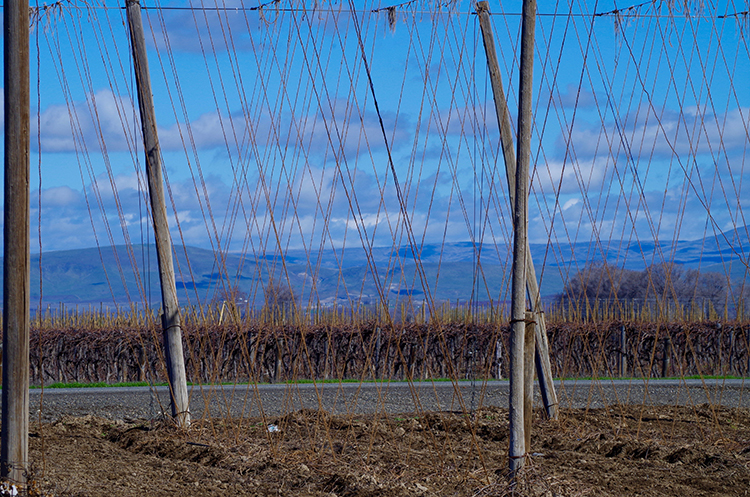A hop yard is a distinctive looking piece of agriculture. Empty or full, a wire and pole trellis system 18 feet high and dozens of acres deep is a hard thing to miss on the roadside. While most folks in the world are scarcely aware of how a hop is grown, anyone from the Yakima Valley finds the boxy silhouette of a hop yard unmistakable and unremarkable. Just another day in the Valley. When they are fleshed out with hops, it’s like a dreadlocked hedge creating a lush barrier. After the hops are harvested, the area looks a bit like a wet cat, the shape of the land seeming not quite right without the extra bulk. Right this very minute though, something is going down. Or maybe it’s coming up? Any way you look at it, it’s twining time in the yard.
Hops are casually referred to as vines but technically they are bines. The true botanical distinction being a vine uses something like a tendril to hold on to something, move and grow from; bines on the other hand move in a circular upward pattern supported by small stiff hairs on the plant that help keep it in place. To fulfill their true vegetative destiny, they need something to facilitate this circular upward growth. Every spring, just as the little pink heads of hop shoots are starting to push out of the ground, farmers start stringing twine from the top trellis wire into the root mass. As the shoots get larger, they are trained clockwise around the twine, and voilà! Upward mobility. First, they grow up, then they fill out. An untwined hop plant bushes out on the ground and can’t really tap its true potential.
 Pulling into the back lot at Cornerstone Ranches this week, tidy stacks of twine are everywhere. Made from coconut husks grown on a breezy shore in Sri Lanka, skeins of twine are unloaded from giant white bales, put in large piles from where they can be placed in soaking pits. Talking to foreman Jorge Cortez, he explains that when the twine is wet, it makes it much easier to grab a single strand and quickly toss it over the top wire to tie off. He would know, he tells me that he himself twined for over 30 years. I ask him to demonstrate the knot for me. He does it quickly and easily, leaving a sturdy tie resembling a pretzel.
Pulling into the back lot at Cornerstone Ranches this week, tidy stacks of twine are everywhere. Made from coconut husks grown on a breezy shore in Sri Lanka, skeins of twine are unloaded from giant white bales, put in large piles from where they can be placed in soaking pits. Talking to foreman Jorge Cortez, he explains that when the twine is wet, it makes it much easier to grab a single strand and quickly toss it over the top wire to tie off. He would know, he tells me that he himself twined for over 30 years. I ask him to demonstrate the knot for me. He does it quickly and easily, leaving a sturdy tie resembling a pretzel.
Walking through a nearby hop yard, I get an up-close look at some twining in action. As I pull into the field, a flatbed truck packed with dripping wet skeins of twine is the first thing I see. After the weekend rain, the ground is pleasantly soft underfoot. The crew is slowly moving toward me as I walk out into the as yet empty yard, the short cut twine leftovers from previous years dangling in the breeze.
Today, three men are on a sled that can be raised up to meet that top wire and pulled by a tractor. The skeins from the flatbed have been unloaded to hang uncoiled off the back of the sled. As the tractor moves forward, they quickly grab a single line, throw it over the approaching wire, and tie it off quickly before bowing their head under the wire. It looks like a dance as this motion is done in a synchronized motion over and over again, wire to wire.
 Grab-throw-tie-bow. Grab-throw-tie-bow. It is easy to see how the weightiness of the water loaded twine streamlines this process. Because it hangs freely after being tied off, workers follow behind to gather up multiple lines and push them into the root mound creating a nice taut line on which to grow. Jorge tells me that it will take about 4 days to complete this 54 acre field.
Grab-throw-tie-bow. Grab-throw-tie-bow. It is easy to see how the weightiness of the water loaded twine streamlines this process. Because it hangs freely after being tied off, workers follow behind to gather up multiple lines and push them into the root mound creating a nice taut line on which to grow. Jorge tells me that it will take about 4 days to complete this 54 acre field. 
And after that there will be beer. Well, maybe not right after, but it’s a beginning.










